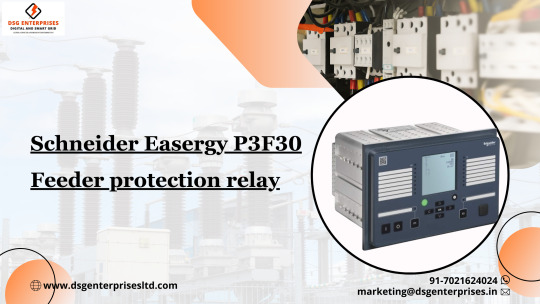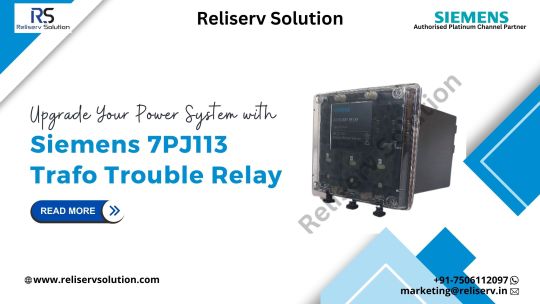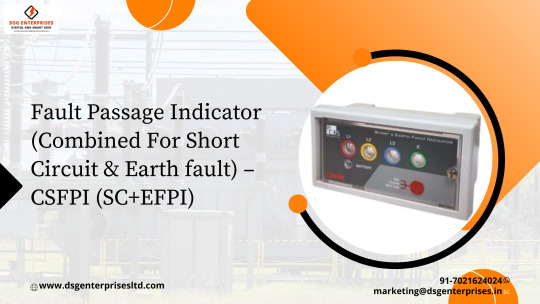#faultdetection
Text

The Schneider Easergy P3F30 Feeder Protection Relay offers advanced protection for electrical distribution networks, ensuring reliable operation and safety. With its precise fault detection capabilities and customizable settings, it provides optimal protection for feeder circuits, enhancing system resilience and efficiency.
C𝐨𝐧𝐭𝐚𝐜𝐭 𝐮𝐬 𝐨𝐧 +91 7021624024 𝐨𝐫 𝐠𝐞𝐭 𝐢𝐧 𝐭𝐨𝐮𝐜𝐡 𝐰𝐢𝐭𝐡 𝐮𝐬 𝐚𝐭 [email protected]
#schneidereasergy#p3f30#feederprotection#relay#electricalsafety#powerdistribution#energyefficiency#faultdetection#systemresilience#electrician#smartgrid#powersystems#gridprotection#industrialautomation#reliabletechnology
0 notes
Text

#siemens#auxiliary#TrafoTrouble#relay#powersystem#electricalengineering#energyefficiency#smartgrid#renewableenergy#powermanagement#industrialautomation#gridprotection#transformermaintenance#faultdetection#powerquality#digitalization#energysolutions#energymanagement
0 notes
Text
Importance of Stability Analysis in Feedback Control Systems: A Comprehensive Guide

In the intricate realm of engineering and automation, where precision and efficiency reign supreme, the significance of stability analysis in feedback control systems cannot be emphasized enough. From regulating the temperature in a chemical reactor to stabilizing the flight of an aircraft, feedback control systems play a vital role in ensuring optimal performance and safety across diverse industries. However, the effectiveness of these systems hinges upon their stability, making stability analysis a fundamental aspect of their design and implementation.
Feedback Control Systems:
At its core, a feedback control system comprises sensors, actuators, and controllers that work harmoniously to maintain desired outputs despite disturbances or uncertainties. The controller continuously adjusts the system’s inputs based on feedback from the sensors, aiming to minimize errors and maintain stability. But what exactly does stability entail in this context?
Stability and Feedback Control Systems:
In simple terms, stability refers to a control system’s ability to return to a desired state following perturbations or disturbances. For example, think of a thermostat maintaining room temperature: if it consistently overshoots or undershoots the setpoint, occupants would experience discomfort, highlighting the importance of stability in achieving reliable outcomes.
Stability analysis involves assessing a control system’s behavior under various conditions to determine its stability characteristics. This analysis typically involves mathematical modeling, simulation, and techniques such as root locus, Nyquist criterion, Bode plots, and frequency response analysis. By scrutinizing the system’s dynamics, engineers can identify potential instability issues and devise corrective measures to enhance performance and reliability.
So, why is stability analysis indispensable in the realm of feedback control systems?
Here are several compelling reasons:
1. Performance Optimization:
- A stable control system exhibits predictable and consistent behavior, allowing engineers to fine-tune its parameters for optimal performance.
- By analyzing stability margins and response characteristics, engineers can identify opportunities to enhance control system performance, such as reducing settling time, improving disturbance rejection, and minimizing overshoot.
2. Safety Assurance:
- In safety-critical applications like nuclear reactors and autonomous vehicles, unstable control systems pose risks to human lives.
- Stability analysis ensures the safety and reliability of these systems by preemptively identifying instability issues and implementing robust control strategies to mitigate risks.
3. Robustness Enhancement:
- Real-world systems are often subject to uncertainties, nonlinearities, and external disturbances that can destabilize control loops.
- Stability analysis allows engineers to assess control system robustness against uncertainties and design controllers capable of maintaining stability across a wide range of operating conditions.
4. Fault Diagnosis and Prevention:
- Instabilities in control systems can arise from component failures, sensor inaccuracies, or environmental changes.
- Monitoring stability over time enables engineers to detect anomalies indicative of potential faults or degradation, facilitating proactive maintenance and preventing catastrophic failures.
5. Cost and Time Savings:
- Detecting and resolving stability issues early in the design phase can save significant time and resources by avoiding costly redesigns, reworks, and downtime associated with unstable control systems.
- Thorough stability analysis upfront streamlines the development process, accelerates time-to-market, and enhances competitiveness.
Conclusion:
In conclusion, stability analysis is a cornerstone of effective feedback control system design and implementation. By rigorously examining stability characteristics, engineers can optimize performance, ensure safety, enhance robustness, facilitate fault diagnosis, and ultimately drive innovation across industries. As technology advances and demand for precise and reliable control systems grows, the importance of stability analysis remains unwavering, guiding engineers toward safer, more efficient, and more resilient solutions. If you want more articles related to these type of topic so visit here👉PujaControls
#automation#labview#plc#labviewsoftware#technology#software development#FeedbackControlSystems#StabilityAnalysis#IndustrialAutomation#EngineeringEfficiency#ControlSystemDesign#SafetyFirst#RobustControl#FaultDetection#OptimalPerformance#PrecisionEngineering
0 notes
Text
What role does AI play in optimizing cloud architecture?
AI plays a crucial role in optimizing cloud architecture by providing intelligent automation, resource management, and decision-making capabilities. Here are some key roles:
Resource Allocation and Scaling: AI algorithms can analyze usage patterns and automatically adjust resources to meet demand, optimizing performance and cost efficiency.
Predictive Analytics: AI enables predictive analytics to forecast future resource needs, allowing proactive adjustments to cloud infrastructure for better scalability and resource utilization.
Automated Provisioning: AI-driven automation can streamline the provisioning of resources, ensuring that the right amount of computing power, storage, and network resources are available on-demand.
Cost Optimization: AI helps in identifying cost-saving opportunities by analyzing usage patterns, suggesting reserved instances, and recommending strategies to minimize unnecessary expenses.
Security: AI can enhance cloud security by continuously monitoring and analyzing data for anomalies, detecting potential security threats, and implementing real-time responses to protect the cloud infrastructure.
Performance Optimization: AI algorithms can analyze performance metrics and make real-time adjustments to enhance application and system performance, ensuring a smooth user experience.
Fault Detection and Resolution: AI can detect anomalies and potential issues in the cloud environment, enabling automated responses or recommendations for resolution before they impact the system's reliability.
By incorporating AI into cloud architecture, organizations can achieve better efficiency, cost-effectiveness, and responsiveness, ultimately optimizing their overall cloud infrastructure.
#magistersign#onlinetraining#usa#support#CloudOptimization#AIinCloud#AutomatedManagement#CostEfficiency#CloudSecurity#ResourceScaling#PredictiveAnalytics#PerformanceEnhancement#FaultDetection#SmartCloudSystems
0 notes
Video
youtube
FAULT DETECTION IN POWER MICROGRID USING REINFORCEMENT LEARNING MATLAB SIMULINK #microgrid #matlab
#youtube#matlab_assignments matlab Simulink microgrid faultdetection electrical electricalengineering
0 notes
Text
"Guardians of the Grid: Unleashing the Power of Medium Voltage Protection Relays 🛡️"
🌟 Trendy Title:Medium Voltage Protection Relays (MV) are the unsung heroes of modern electrical systems, ensuring the resilience and reliability of our power infrastructure.
These intelligent devices stand as vigilant sentinels, detecting and swiftly responding to anomalies like overcurrents, overvoltages, and short circuits, preventing potential damage and downtime. With advanced technology and adaptive algorithms, MV relays optimize grid performance, enhancing stability and efficiency in the face of evolving energy demands and environmental challenges. As industries embrace the transition to smarter, more resilient grids, MV protection relays play a pivotal role in safeguarding our energy future. #MediumVoltage #ProtectionRelays #GridResilience #ElectricalEngineering #EnergyInfrastructure #SmartGrid #PowerProtection #Reliability #FaultDetection #GridSecurity #EnergyManagement #ResilientInfrastructure #Innovation #SustainableEnergy #PowerGrid
0 notes
Text
Finding the Perfect Fit: Choosing the Most Suitable Relays for Different Power Grid Applications
In power grids, relays play a crucial role in protecting electrical systems from faults and ensuring their reliable and safe operation. However, selecting the right relays for specific applications can be a complex task. In this post, we will explore key factors to consider and provide guidance for choosing the most suitable relays based on specific power grid applications.
1. Overcurrent Protection:
Overcurrent events can occur due to various reasons, like short circuits or equipment malfunctions. To protect against these events, overcurrent relays are essential. When selecting overcurrent relays, consider the expected load current magnitude, fault current levels, and coordination with upstream and downstream protective devices.
2. Distance Protection:
Distance relays are used to protect transmission lines by measuring the impedance between the relay location and the fault location. Factors to consider when selecting distance relays include fault location accuracy, fault resistance detection capability, and speed of operation.
3. Differential Protection:
Differential relays compare current inputs on both sides of a protective zone to detect internal faults within transformers, generators, or busbars. Considerations when choosing differential relays include sensitivity requirements, operating characteristics (adaptive or fixed), and communication capabilities.
4. Generator Protection:
Generators are critical components of power grids, and protecting them from faults is essential. When choosing relays for generator protection, parameters such as stator winding faults, rotor faults, loss of excitation, and loss of synchronization must be taken into account.
5. Transformer Protection:
Transformers are vital for voltage conversion and supply stability. Transformer protection relies on various aspects such as overcurrent protection, differential protection, backup protection schemes, and thermal protection to safeguard against faults.
6. Motor Protection:
Motors are key elements that drive industrial processes, and their protection is critical for uninterrupted operations. Motor protection relays should consider factors like overload protection, phase asymmetry, locked rotor detection, and thermal model-based protection.
Conclusion:
Selecting the most suitable relays for specific power grid applications requires careful analysis of various aspects, including fault types, system topology, coordination requirements, and desired response times. It is essential to consult with experts, refer to industry standards, and leverage the experience of relay manufacturers to ensure the optimal selection for a reliable and effective protection scheme. By considering these factors, power grid operators can enhance the safety and stability of their systems.
Remember, every power grid is unique, so it's crucial to tailor the selection of relays to the specific needs and characteristics of your own system.
#PowerGrid #RelaySelection #ElectricalProtection #OvercurrentProtection #DistanceProtection #DifferentialProtection #GeneratorProtection #TransformerProtection #MotorProtection #FaultDetection
0 notes
Video
. با استفاده از کلید آشکار ساز زود هنگام آرک ( جرقه ) Arc fault detector میتوانید از بروز %90 از آتش سوزی های ناشی از جرقه الکتریکی در ساختمان ها جلو گیری کنید. @DGminer #dgminer #asicminer #asicmaintenance #asic #cryptominingfarm #cryptominingfarm #cryptomining #bitcoinmining #faultdetection #arc_fault #دیجیماینر #دیجی_ماینر #استخراج_ارز_دیجیتال #ارزدیجیتال #ارزدیجیتالی #ایسیک_ماینر #ایسیک #ایسیک_بوست #بیتکوین #بیتکوین_ماینر (at Tehran, Iran) https://www.instagram.com/p/BysArZCnQU6/?igshid=cjr5391oe41g
#dgminer#asicminer#asicmaintenance#asic#cryptominingfarm#cryptomining#bitcoinmining#faultdetection#arc_fault#دیجیماینر#دیجی_ماینر#استخراج_ارز_دیجیتال#ارزدیجیتال#ارزدیجیتالی#ایسیک_ماینر#ایسیک#ایسیک_بوست#بیتکوین#بیتکوین_ماینر
0 notes
Text

Fault Passage Indicator for Earth, is engineered to identify and signal Earth faults within a cable system, specifically in RMU networks configured with a single input or an open ring arrangement. When the current surpasses predetermined trip settings, the unit promptly signals a fault condition. The detection of fault current is facilitated by a sensor mounted on the cable, which then transmits a signal to the indication unit.
𝐂𝐨𝐧𝐭𝐚𝐜𝐭 𝐮𝐬 𝐨𝐧 +91 7021624024 𝐨𝐫 𝐠𝐞𝐭 𝐢𝐧 𝐭𝐨𝐮𝐜𝐡 𝐰𝐢𝐭𝐡 𝐮𝐬 𝐚𝐭 [email protected]
#faultpassageindicator#shortcircuit#earthfault#csfpi#scefpi#electricalsafety#faultdetection#cablemanagement#powerdistribution#safetysystem#industrialautomation#energyefficiency#powergrid#utilities
0 notes
Video
youtube
FAULT SIMULATION IN MULTIPLE TANK SYSTEM-THREE TANK SYSTEM CASE STUDY - #electrical #faultdetection
#youtube#matlab_assignments matlab Simulink electrical electricalengineering threetanksystem faultdetection faultsimulation
0 notes
Text
⚡💼 Protection relays have been crucial in ensuring reliable and safe operation in electrical power systems. To ensure best practices, let's explore key guidelines!
1️⃣ System Planning and Coordination: Adequate planning and coordination improve fault detection and isolation. #PowerSystemPlanning #CoordinationStudy
2️⃣ Equipment Selection and Application: Ensure suitable protective devices for different system equipment to detect faults effectively. #ProtectiveDevices #FaultDetection
3️⃣ Risk Assessment and Fault Analysis: Analyze potential hazards, fault currents, and locations for designing proper protection schemes. #RiskAssessment #FaultAnalysis
4️⃣ Redundancy and Backup Protection: Incorporate alternate paths for power flow during faults or primary protection device failure. #Redundancy #BackupProtection
5️⃣ Reliability Testing and Maintenance: Regularly test and maintain protective relays to verify correct operation and reliability. #ReliabilityTesting #MaintenanceBestPractices
6️⃣ Cybersecurity Measures: Protect communication networks, data confidentiality, and secure remote access to protection devices. #Cybersecurity #ProtectiveDevices
7️⃣ Training and Documentation: Comprehensive training and proper documentation enhance efficient management and facilitate modifications. #Training #Documentation
8️⃣ Continuous Monitoring and Condition Monitoring: Deploy real-time monitoring systems for early fault detection and preventive maintenance. #ContinuousMonitoring #ConditionMonitoring
📜 Standard Recommendation: The IEC 61850 standard provides guidelines for protection, control, and automation in power systems. #IEC61850
Remember, safety should always be prioritized in any protection strategy to safeguard personnel, equipment, and the environment.
Join the discussion by sharing your experiences and insights on power systems protection! 💬⚙️ #PowerSystemsProtection #SafetyFirst
0 notes
Text
🔌💡🔬 Calling all power system enthusiasts! Let's dive into the world of IEEE standards for power system studies. 📚👩💻
📌 IEEE 1159-2019: Keep your power quality in check with this recommended practice for monitoring electric power quality. #PowerQuality #IEEE1159
📌 IEEE 141-1993 (Red Book): Need guidance on designing, installing, and operating power distribution systems for industrial plants? This recommended practice has you covered. #PowerDistribution #IndustrialPlants #IEEE141
📌 IEEE 421.5-2016: Want to improve fault detection and system reliability in air-insulated substations? Check out this guide on applying faulted circuit indicators. #Substations #FaultDetection #SystemReliability #IEEE4215
📌 IEEE 433-2011: Ensure reliable power systems for your industrial and commercial facilities with this recommended practice for design. #Reliability #PowerSystems #DesignGuidelines #IEEE433
📌 IEEE C37.105-2007 (R2017): Nuclear power generating stations require specialized protective relays. Find out the requirements to qualify Class 1E relays and auxiliaries in this standard. #NuclearPower #ProtectiveRelays #IEEEC37105
📌 IEEE C37.238-2011: Maintain proper function and reliability of relays and relay systems associated with electric power apparatus with this comprehensive standard. #Relays #ElectricPowerApparatus #SystemReliability #IEEEC37238
📌 IEEE 519-2014: Harmonics causing headaches? This recommended practice provides requirements for harmonic control in power systems. #Harmonics #PowerSystems #HarmonicControl #IEEE519
📌 IEEE 1584-2018: Protect your personnel from arc-flash hazards with this guide for performing arc-flash hazard calculations. #ArcFlash #HazardCalculations #ElectricalSafety #IEEE1584
📌 IEEE C37.100-2017: Understand crucial terms and concepts related to power switchgear with this standard's definitions. #PowerSwitchgear #Terminology #IEEEC37100
📌 IEEE C37.232-2011 (R2018): Need a common format for naming time sequence data files? Look no further than this standard. #TimeSequenceDataFiles #PowerSystemAnalysis #CommonFormat #IEEEC37232
There are several other global organizations that you might consider. Some of the prominent ones include:
1. International Electrotechnical Commission (IEC): The IEC develops and publishes international standards for electrical engineering, electronics, and related technologies. Their standards cover a wide range of areas, including power systems, renewable energy, electrical safety, and more.
2. International Organization for Standardization (ISO): ISO is an independent and non-governmental organization that develops and publishes international standards across various industries. While ISO standards are not specific to engineering or technology, they often include standards related to quality management, environmental management, energy management, and many other areas relevant to engineering practices.
3. American National Standards Institute (ANSI): ANSI is a private non-profit organization that oversees the development of voluntary consensus standards in the United States. They facilitate the creation of industry standards across multiple sectors, including technology, energy efficiency, and safety.
4. British Standards Institution (BSI): BSI is the national standards body for the UK and develops standards across diverse sectors, including engineering, construction, manufacturing, and services. They publish British Standards (BS) and also contribute to the development of European and international standards.
These organizations play significant roles in establishing standards that promote safety, quality, and interoperability across industries globally. It's important to consult the respective websites of these organizations to access specific standards or obtain more information about their areas of focus and publications.
Keep up with the latest standards in power systems studies by checking out these resources. Happy learning! 📖✨
0 notes
Text
🔌💡 Understanding Key Concepts and Protocols in Industrial Automation 💡🔌
In the realm of industrial automation, several key concepts and protocols play crucial roles in ensuring efficient and reliable system operation. Let's explore three important concepts: remote terminal units (RTUs), programmable logic controllers (PLCs), and human-machine interfaces (HMIs), along with popular communication protocols like Modbus, DNP3 (Distributed Network Protocol), and OPC (OLE for Process Control):
1️⃣ Remote Terminal Units (RTUs): RTUs are devices deployed in industrial environments to monitor and control remote equipment or processes. They collect data from sensors and other devices, communicate with PLCs or control centers, and execute commands for process control. RTUs are typically installed in remote locations where wired connections may not be feasible.
2️⃣ Programmable Logic Controllers (PLCs): PLCs are specialized computers used to automate industrial processes and machinery. They monitor inputs from various sensors, execute programmed logic based on predefined rules, and control outputs to achieve desired outcomes. PLCs are highly flexible and allow for real-time monitoring and control of complex automation systems.
3️⃣ Human-Machine Interfaces (HMIs): HMIs provide a graphical interface that allows operators to interact with and monitor industrial automation systems. HMIs enable real-time visualization of process data, control system parameters, and facilitate efficient troubleshooting. They enhance the accessibility and usability of complex automation systems.
Now, let's delve into communication protocols commonly used in industrial automation:
- Modbus: Modbus is a widely adopted serial communication protocol used to connect various devices in a network. It provides a simple and robust means of data exchange between devices, such as PLCs, RTUs, and HMIs.
- DNP3: Distributed Network Protocol (DNP3) is designed specifically for utility automation systems. It enables secure and reliable communication between devices, including RTUs, PLCs, and SCADA systems. DNP3 supports efficient data transfer in challenging environments and ensures timely fault detection and response.
- OPC (OLE for Process Control): OPC is a standard interface protocol widely used in industrial automation. It allows different software applications to communicate with each other seamlessly. OPC facilitates data exchange between controllers, HMIs, databases, and other devices, fostering interoperability and enhancing system efficiency.
By understanding concepts like RTUs, PLCs, and HMIs, along with protocols like Modbus, DNP3, and OPC, engineers can design and implement robust industrial automation systems with enhanced operational efficiency and reliability.
#industrialautomation #RTU #PLC #HMI #Modbus #DNP3 #OPC #processcontrol #faultdetection #realtime #engineering #technology
0 notes
Text
🔌💡 Communication Protocols of Power Systems Relaying: Ensuring Reliable Grid Protection 💡🔌
Relaying plays a critical role in protecting power systems from faults and ensuring grid reliability. Let's explore the importance of communication protocols in power systems relaying:
1️⃣ Understanding Communication Protocols: Communication protocols are set of rules that govern the exchange of information between relays, substations, and control centers in a power system. These protocols ensure reliable and accurate data transfer, coordination, and operation of protective devices.
2️⃣ Commonly Used Communication Protocols: Several communication protocols are widely used in power systems relaying. Some examples include IEC 61850, DNP3, Modbus, Profibus, and OPC. Each protocol has its own specifications, advantages, and areas of application.
3️⃣ Role in Fault Detection and Isolation: Communication protocols enable relays to exchange information about fault conditions, such as fault type, location, and magnitude. This information allows for quick and accurate fault detection and isolation, minimizing the impact of faults on the power system and reducing downtime.
4️⃣ Fast and Secure Data Exchange: Reliable communication protocols facilitate fast data exchange between protective devices, relays, and control centers. This real-time information sharing helps ensure coordinated protection and allows for quick decision-making to mitigate potential issues.
5️⃣ Integration with SCADA Systems: Communication protocols also play a crucial role in integrating protective relays with SCADA (Supervisory Control And Data Acquisition) systems. This integration allows for centralized monitoring and control of the power system, enhancing its efficiency and reliability.
By utilizing robust communication protocols in power systems relaying, engineers can enhance grid protection, improve fault response times, and maintain a reliable electrical network.
#power #powersystem #relaying #communicationprotocols #gridprotection #engineering #technology #SCADA #faultdetection #reliability #tumblr
0 notes
Video
youtube
FAULT SIMULATION IN MULTIPLE TANK SYSTEM-THREE TANK SYSTEM CASE STUDY - #electrical #faultdetection
0 notes
Video
youtube
FAULT SIMULATION IN MULTIPLE TANK SYSTEM-THREE TANK SYSTEM CASE STUDY - #electrical #faultdetection
0 notes